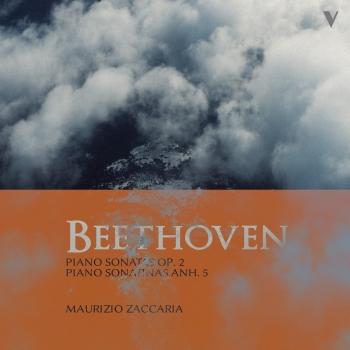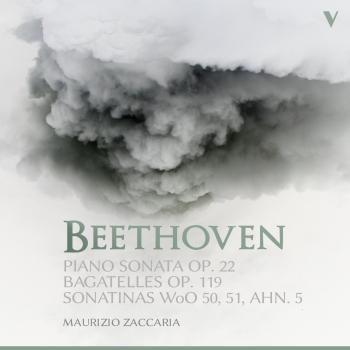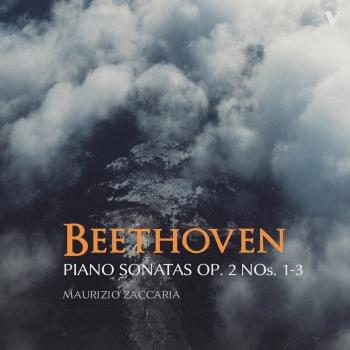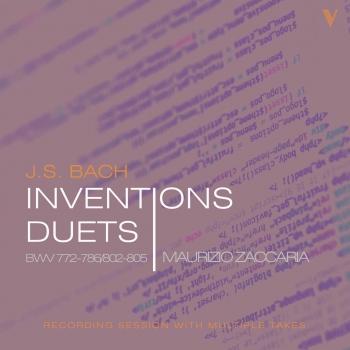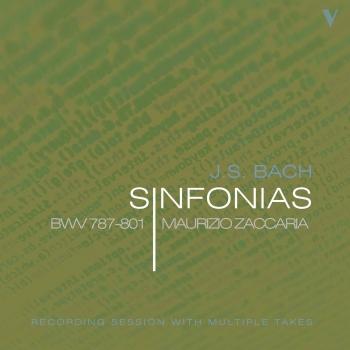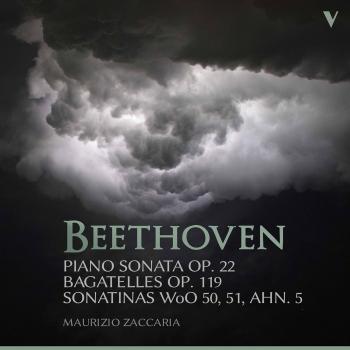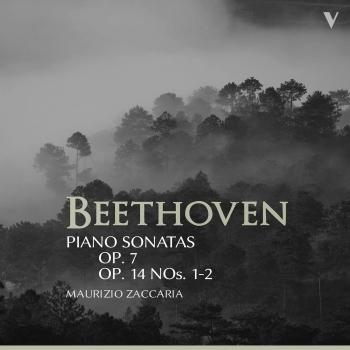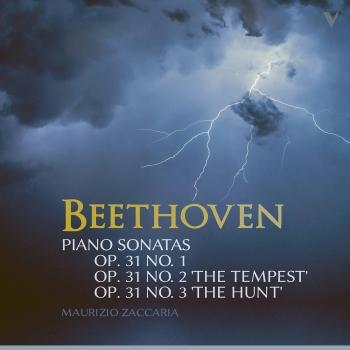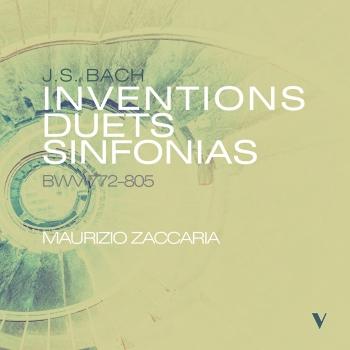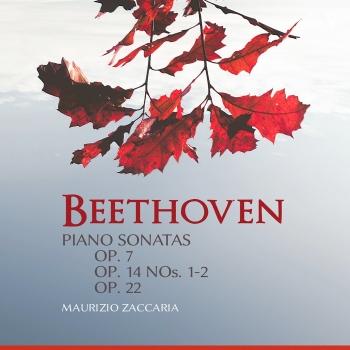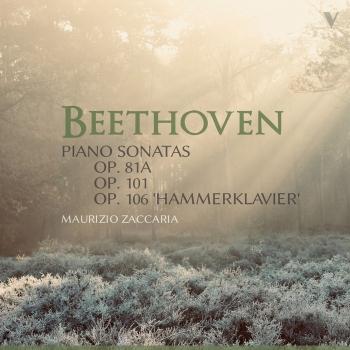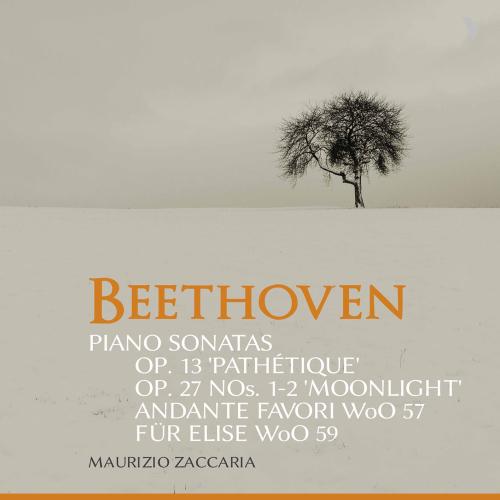
Beethoven: Piano Sonatas, Opp. 13 & 27 & Other Works Maurizio Zaccaria
Album info
Album-Release:
2020
HRA-Release:
17.04.2020
Label: OnClassical
Genre: Classical
Subgenre: Instrumental
Artist: Maurizio Zaccaria
Composer: Ludwig van Beethoven (1770–1827)
Album including Album cover
- Ludwig van Beethoven (1770 - 1827): Piano Sonata No. 8 in C Minor, Op. 13 "Pathétique":
- 1 Piano Sonata No. 8 in C Minor, Op. 13 "Pathétique": I. Grave - Allegro di molto e con brio 08:54
- 2 Piano Sonata No. 8 in C Minor, Op. 13 "Pathétique": II. Adagio cantabile 05:23
- 3 Piano Sonata No. 8 in C Minor, Op. 13 "Pathétique": III. Rondo. Allegro 04:25
- Piano Sonata No. 13 in E-Flat Major, Op. 27 No. 1 "Quasi una fantasia":
- 4 Piano Sonata No. 13 in E-Flat Major, Op. 27 No. 1 "Quasi una fantasia": I. Andante 03:50
- 5 Piano Sonata No. 13 in E-Flat Major, Op. 27 No. 1 "Quasi una fantasia": II. Allegro molto e vivace 01:50
- 6 Piano Sonata No. 13 in E-Flat Major, Op. 27 No. 1 "Quasi una fantasia": III. Adagio con espressione 02:38
- 7 Piano Sonata No. 13 in E-Flat Major, Op. 27 No. 1 "Quasi una fantasia": IV. Allegro vivace 05:45
- Piano Sonata No. 14 in C-Sharp Minor, Op. 27 No. 2 "Moonlight":
- 8 Piano Sonata No. 14 in C-Sharp Minor, Op. 27 No. 2 "Moonlight": I. Adagio sostenuto 05:00
- 9 Piano Sonata No. 14 in C-Sharp Minor, Op. 27 No. 2 "Moonlight": II. Allegretto 02:25
- 10 Piano Sonata No. 14 in C-Sharp Minor, Op. 27 No. 2 "Moonlight": III. Presto con fuoco 07:26
- Andante favori in F Major, WoO 57:
- 11 Andante favori in F Major, WoO 57 10:53
- Bagatelle in A Minor, WoO 59 "Für Elise":
- 12 Bagatelle in A Minor, WoO 59 "Für Elise" 03:05
Info for Beethoven: Piano Sonatas, Opp. 13 & 27 & Other Works
In the first decade of his career as a published composer, Ludwig van Beethoven completed an enormous amount of music. Some of the most beloved sonatas for piano belong to this prolific period, marked not only by the desire to be acknowledged as an emerging composer of his time, but also by wonderfully creative inspiration and innovation. All of these sonatas are crucial in the way Beethoven understood both musical forms and the possibilities of the piano as the new household instrument.
The Sonata in C Minor, Op. 13 was published in 1799 by Eder as “Grande sonate pathetique” – a title not by Beethoven but by the publisher, and which the composer nonetheless liked (Eder found the piece’s dramatic sonorities greatly affecting). The frontispiece indicates that the work is composed for harpsichord or piano - to increase sales, since many people in Vienna still owned harpsichords (all the sonatas for piano that Beethoven published until then were sold as works written for both instruments). Here Beethoven experiments with novel ideas about form in the outer movements - innovations which will influence contemporaneous and future composers.
The Two Sonatas, Op. 27, composed in the year 1800, were subtitled by Beethoven “Sonata quasi una fantasia” for the freedom with which their structures were conceived. Both sonatas present unusual features – the first, in E-flat major, almost cyclical, structurally evokes a fantasy wherein different movements are played without interruption. The structure is made more complex by the return of slow movement at the end of the work, before the closing coda. The second sonata, in C-sharp minor, presents two movements in sonata form - the first an Adagio, and the second featuring unusual harmonic relations between the two main thematic blocks. Franz Liszt aptly proclaimed that the second movement, a simple minuet in the key of D-flat major in ABA form, is “a flower between two abysses.” The second sonata from Op. 27 was nicknamed Mondschein (“Moonlight”) by the German critic Ludwig Rellstab in 1835, as its first movement evoked in his mind the silvery moon reflecting on the placid Lake Lucerne.
The album leaf in rondo form known today as “Fur Elise” was composed in 1810 and published posthumously in 1867, forty years after Beethoven’s death. It has become one of the composer’s most beloved and recognizable works, and possibly one of the most frequently performed and recorded works for piano today. The title comes from Beethoven’s dedication in the now lost manuscript – “Fur Elise am 27 April zur Erinnerung von L. v. Bthvn" ("For Elise on April 27 in memory of L. van Beethoven"). Though many speculations have risen, the identity of Elise has not been established with certainty.
Maurizio Zaccaria (Massenet, J.: Complete Piano Music - AE16003 AEVEA; Gershwin, G.: (Complete) Published Piano Works - AE17032 AEVEA), begins his music journey exploring the Beethovenian universe with his integral Piano Sonatas (32 + 4) in a view that is something original, explosive and fully pianistic.
All the set was and will be recorded on two Steinway's grand D-274 by sound engineer and producer Alessandro Simonetto (OnClassical), in perfect stereo 88.2x24-bits, using historical microphones.
Maurizio Zaccaria, piano
Maurizio Zaccaria
After a diploma in piano at "Niccola Piccinni" Conservatory of Music in Bari under the guidance of Gregorio Goffredo and a master at "Nino Rota" Conservatory of Music in Monopoli under the guidance of Benedetto Lupo, he attended the masterclasses of Marisa Somma, Cristian Zaccarias, Joaquin Achucarro, Francois J. Thiollier, Konstantin Bogino et Aldo Ciccolini.
He went on to win several national and international piano competitions: Rachmaninoff International Piano Competition, Liszt International Piano Competition (the famous Argentine pianist Martha Argerich was in the jury), Thalberg International Piano Competition, International Music Competition in Ibla, "San Nicolaus" International Piano Competition International, Piano Festival in Osnabruch (Germania), Cliburn Piano Competition in Texas (USA). In 2008 he was awarded the "Umanitaria" Society price in Milan (president Maestro Abbado); during the same year he was also awarded the Arts Price of the Italian Cultural Ministry, after which he played at the Parco della Musica in Rome. He plays in Italy and abroad in some important halls: Auditorium della Radio Televisione Svizzera (Lugano); Salle Cortot (Paris); Institut Italien de Culture (Paris); Sala Gaber (Milan); Parco della Musica (Rome); Sala Scarlatti (Naples); Teatro delle Muse (Ancona); Teatro Piccinni et Kursaal Santa Lucia (Bari); Teatro Bibiena (Mantova); Villa Ruffolo (Ravello); Teatro Wan Vesterhout (Mola di Bari); Auditorium V. Falco (playing two pianos with Aldo Ciccolini); Teatro Curci (Bari). Maurizio Zaccaria plays for important associations: Fondazione Petruzzelli (Bari); URTIcanti contemporary music festival; Ravello festival; PianoFestival (Grosseto); A.R.A.M. (Rome); Gaeta Festival; Accademia dei Cameristi (Bari). In March 2007 he debuted in the USA, during a series of concerts playing Bartok's compositions, among which his Sonata for two pianos and percussions. His last concerts with Bari Concert Society orchestra and Taranto Magna Grecia orchestra, respectively devoted to Shostakovic's Concerto Op. 35 and Rachmaninoff's Third Concerto Op. 30 have fascinated audience and critics. He played as a soloist with Petruzzelli Symphonic Orchestra, (Bari), "Nino Rota" orchestra (Monopoli, Bari) conducted by Filippo Maria Bressan, with Cosenza Symphonic orchestra, Bacau symphonic orchestra, Matera Duni Orchestra (there he played Gershwin's best symphonic pieces for piano, Concerto in Fa and Rapsody in Blue) and with Bari Metropolitan Symphonic orchestra. He was invited by the Italian embassy in Pogdorica where he played music by Fauré, Debussy and Schostakovic. He is also a composer, and he debuted some compositions by Goeffroy Drouin, Luca Lombardi, Lera Auerbach, Luca Mosca, Andrea Marena and Fabio Vacchi. He also pays chamber music and he collaborates with flutist Leonardo Grittani.
This album contains no booklet.












